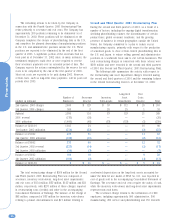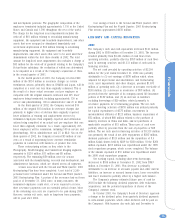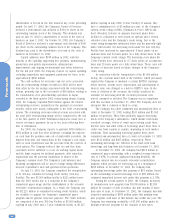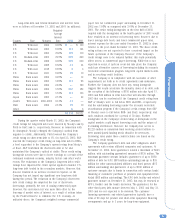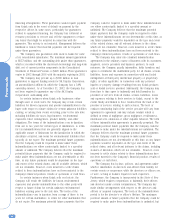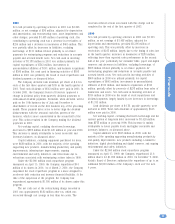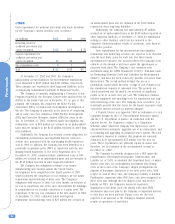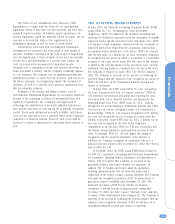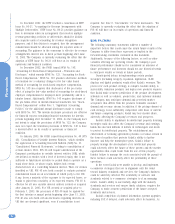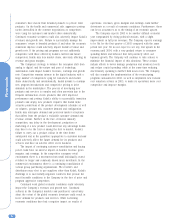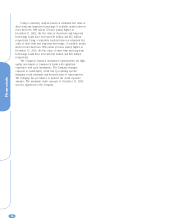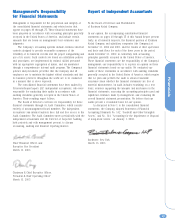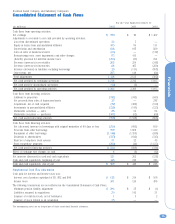Kodak 2002 Annual Report Download - page 33
Download and view the complete annual report
Please find page 33 of the 2002 Kodak annual report below. You can navigate through the pages in the report by either clicking on the pages listed below, or by using the keyword search tool below to find specific information within the annual report.
Financials
33
The Clean Air Act Amendments were enacted in 1990.
Expenditures to comply with the Clean Air Act implementing
regulations issued to date have not been material and have been
primarily capital in nature. In addition, future expenditures for
existing regulations, which are primarily capital in nature, are not
expected to be material. Many of the regulations to be
promulgated pursuant to this Act have not been issued.
Uncertainties associated with environmental remediation
contingencies are pervasive and often result in wide ranges of
outcomes. Estimates developed in the early stages of remediation
can vary significantly. A finite estimate of cost does not normally
become fixed and determinable at a specific time. Rather, the
costs associated with environmental remediation become
estimable over a continuum of events and activities that help to
frame and define a liability, and the Company continually updates
its cost estimates. The Company has an ongoing monitoring and
identification process to assess how the activities, with respect to
the known exposures, are progressing against the accrued cost
estimates, as well as to identify other potential remediation sites
that are presently unknown.
Estimates of the amount and timing of future costs of
environmental remediation requirements are necessarily imprecise
because of the continuing evolution of environmental laws and
regulatory requirements, the availability and application of
technology, the identification of presently unknown remediation
sites and the allocation of costs among the potentially responsible
parties. Based upon information presently available, such future
costs are not expected to have a material effect on the Company’s
competitive or financial position. However, such costs could be
material to results of operations in a particular future quarter or
year.
NEW ACCOUNTING PRONOUNCEMENTS
In June 2001, the Financial Accounting Standards Board (FASB)
issued SFAS No. 143, “Accounting for Asset Retirement
Obligations.” SFAS 143 addresses the financial accounting and
reporting for obligations associated with the retirement of tangible
long-lived assets and the associated asset retirement costs. SFAS
143 applies to legal obligations associated with the retirement of
long-lived assets that result from the acquisition, construction,
development and/or normal use of the assets. SFAS 143 requires
that the fair value of a liability for an asset retirement obligation
be recognized in the period in which it is incurred if a reasonable
estimate of fair value can be made. The fair value of the liability
is added to the carrying amount of the associated asset, and this
additional carrying amount is expensed over the life of the asset.
The Company is required to adopt SFAS 143 effective January 1,
2003. The Company is currently in the process of evaluating the
potential impact that the adoption of the recognition provisions of
SFAS 143 will have on its consolidated financial position and
results of operations.
In June 2002, the FASB issued SFAS No. 146, “Accounting
for Costs Associated with Exit or Disposal Activities.” SFAS No.
146 addresses the financial accounting and reporting for costs
associated with exit or disposal activities and supercedes the
Emerging Issues Task Force (EITF) Issue No. 94-3, “Liability
Recognition for Certain Employee Termination Benefits and Other
Costs to Exit an Activity (including Certain Costs Incurred in a
Restructuring).” SFAS No. 146 requires recognition of the liability
for costs associated with an exit or disposal activity when the
liability is incurred. Under EITF issue No. 94-3, a liability for an
exit cost was recognized at the date of the Company’s
commitment to an exit plan. SFAS No. 146 also establishes that
the liability should initially be measured and recorded at fair
value. Accordingly, SFAS No. 146 will impact the timing of
recognition and the initial measurement of the amount of
liabilities the Company recognizes in connection with exit or
disposal activities initiated after December 31, 2002, the effective
date of SFAS No. 146.
In November 2002, the FASB issued FASB Interpretation No.
45 (FIN 45), “Guarantor’s Accounting and Disclosure Requirements
for Guarantees, Including Indirect Guarantees of Indebtedness of
Others.” FIN 45 requires that a liability be recorded on the
guarantor’s balance sheet upon issuance of a guarantee. In
addition, FIN 45 requires disclosures about the guarantees,
including indemnifications, that an entity has issued and a
rollforward of the entity’s product warranty liabilities. The Company
will apply the recognition provisions of FIN 45 prospectively to
guarantees issued or modified after December 31, 2002. The
disclosure provisions of FIN 45 are effective for financial
statements of interim periods or annual periods ending after
December 15, 2002. See Note 1 under “Warranty Costs” and Note
10 under “Other Commitments and Contingencies.” The Company is
currently in the process of evaluating the potential impact that the
adoption of the recognition provisions of FIN 45 will have on its
consolidated financial position and results of operations.



